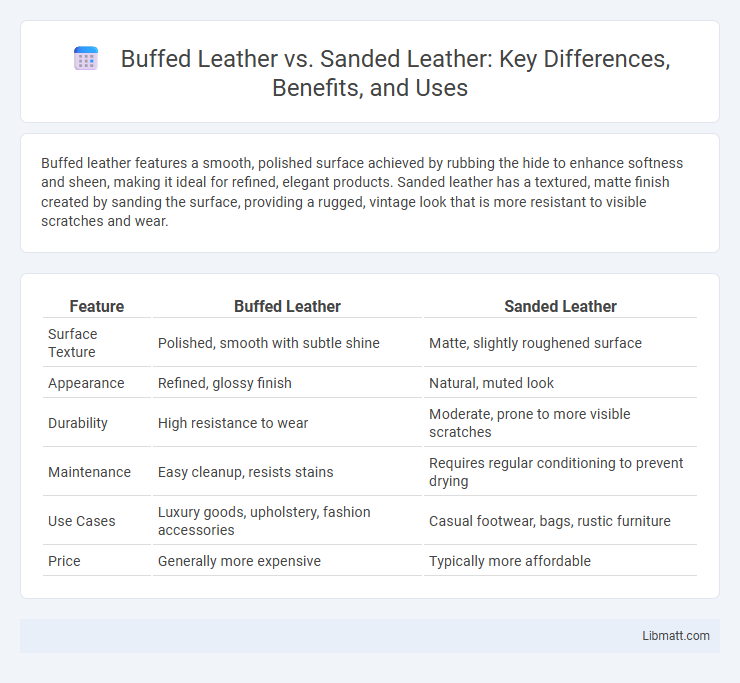Buffed leather features a smooth, polished surface achieved by rubbing the hide to enhance softness and sheen, making it ideal for refined, elegant products. Sanded leather has a textured, matte finish created by sanding the surface, providing a rugged, vintage look that is more resistant to visible scratches and wear.
Table of Comparison
| Feature | Buffed Leather | Sanded Leather |
|---|---|---|
| Surface Texture | Polished, smooth with subtle shine | Matte, slightly roughened surface |
| Appearance | Refined, glossy finish | Natural, muted look |
| Durability | High resistance to wear | Moderate, prone to more visible scratches |
| Maintenance | Easy cleanup, resists stains | Requires regular conditioning to prevent drying |
| Use Cases | Luxury goods, upholstery, fashion accessories | Casual footwear, bags, rustic furniture |
| Price | Generally more expensive | Typically more affordable |
Introduction to Buffed and Sanded Leather
Buffed leather features a smooth surface achieved by lightly sanding the top grain, enhancing its natural texture and durability. Sanded leather, on the other hand, undergoes a more aggressive sanding process that removes the top layer, exposing the fibrous interior for a softer, matte finish. Understanding these differences helps you choose the right leather type based on desired appearance and wear resistance.
Defining Buffed Leather
Buffed leather is defined by its smooth, softened surface achieved through light abrasion that removes imperfections and creates a velvety texture. This treatment enhances the leather's appearance by revealing the natural grain while maintaining durability and flexibility. Understanding the distinction between buffed leather and sanded leather helps you select the right finish based on the desired aesthetic and wear characteristics.
What is Sanded Leather?
Sanded leather is a type of leather that has been mechanically abraded to create a soft, velvety texture by buffing away the top grain or finishing layer. This process exposes the natural fibrous surface, enhancing the leather's breathability and giving it a matte, suede-like appearance. Sanded leather is commonly used in upholstery, footwear, and fashion accessories where a tactile, rustic look is desired over the smoother finish of buffed leather.
Key Differences Between Buffed and Sanded Leather
Buffed leather features a smooth, polished surface achieved by lightly sanding and polishing the grain, enhancing its natural texture and durability, while sanded leather undergoes a more aggressive sanding process that removes the top grain to create a soft, velvety nap often seen in suedes. Buffed leather retains more of the hide's original strength and water resistance compared to sanded leather, which is more susceptible to stains and requires careful maintenance. The choice between buffed and sanded leather affects the leather's appearance, texture, and longevity based on the specific finishing techniques applied.
Production Processes Compared
Buffed leather undergoes a mechanical abrasion process that smooths the surface by removing imperfections, enhancing its softness and creating a matte finish. Sanded leather is produced by sanding the grain surface to achieve a uniform texture, often exposing the inner layers for a more distinctive appearance. The key difference lies in buffing targeting minor surface corrections while sanding results in a rougher, more natural aesthetic.
Appearance and Texture Contrast
Buffed leather exhibits a smooth, polished surface with a subtle sheen, highlighting the natural grain and providing a slightly glossy finish. Sanded leather features a matte, velvety texture achieved by sanding the hide, which softens the surface and creates a more uniform, subdued appearance. The contrast between buffed leather's sleek, reflective quality and sanded leather's muted, tactile feel makes each ideal for different aesthetic and tactile preferences in leather goods.
Durability and Performance
Buffed leather exhibits enhanced durability due to its thicker surface layer, making it highly resistant to wear and scratches, ideal for heavy-use items. Sanded leather, with its thinner, softer finish, offers superior flexibility and breathability but requires more maintenance to prevent damage from abrasions. Both types perform well under different conditions, with buffed leather excelling in rugged applications and sanded leather preferred for comfort and appearance.
Common Uses in Fashion and Upholstery
Buffed leather, known for its soft, velvety texture, is commonly used in fashion for high-end jackets, gloves, and handbags due to its luxurious feel and durability. Sanded leather, with its matte finish and slightly rougher surface, is favored in upholstery for sofas, chairs, and car interiors because it offers excellent grip and hides scratches effectively. Both types are chosen for their unique aesthetic qualities and practical benefits, enhancing the longevity and appearance of fashion items and furniture.
Care and Maintenance Requirements
Buffed leather requires regular conditioning to maintain its smooth finish and prevent drying or cracking, as its surface is lightly polished to enhance texture. Sanded leather demands more frequent cleaning due to its rougher, porous surface, which can trap dirt and stains more easily, making protective treatments essential to preserve its appearance. Your choice should consider the level of upkeep you're prepared for, as buffed leather offers easier maintenance while sanded leather needs consistent care to avoid damage.
Which Leather Type Should You Choose?
Buffed leather offers a smooth, polished surface with enhanced durability and resistance to stains, making it ideal for items subjected to frequent wear and tear. Sanded leather features a softer, suede-like texture that provides a luxurious feel and a more casual appearance, but it requires more care to prevent damage and staining. Your choice depends on whether you prioritize long-lasting toughness and easy maintenance or prefer a delicate, refined look with a softer touch.
Buffed leather vs sanded leather Infographic

 libmatt.com
libmatt.com